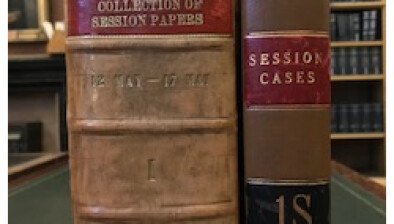Session Cases At 200: A ‘gallery of mirrors’

Lord Stewart
Like something out of Borges, Lord Stewart discusses the report of Thom v Black 1828 7 S 158 – his choice for the top entry in Session Cases. Nominate your favourite cases here.
“The law on this subject cannot be better expressed than it is by Monkbarns in a work of fiction, with which we are all well acquainted.” Thus Lord Gillies, giving a preliminary view of the case Thom v Black in the First Division, reported 1828 7 S 158. The “S” stands for “Shaw”.
Patrick Shaw’s report is of interest for the fact that unusually if not uniquely for a law report – at least for a law report which is not concerned with literary property – it includes a long quotation from a novel, added by way of Shaw’s footnote, as if the novelist were an “Institutional Writer”. The novel is The Antiquary, and the passage footnoted is the one alluded to by Lord Gillies containing a disquisition by the antiquary of the title, Jonathan Oldbuck of Monkbarns, on “the elegance of the legal fiction” which underlies the warrant to incarcerate debtors decamping in meditatione fugae.
The reflections of Lord Gillies lead us into a gallery of mirrors, using as they do literary fiction to explain a legal fiction, itself an ambiguous phrase meaning both a fiction of the law and a fiction about the law – the latter being a fair description of The Antiquary as of many other tales from the same pen. (Especially relevant is Redgauntlet, in which a “fugie warrant” is one of the drivers of the action.) The words “with which we are all well acquainted” suggest a circle of initiates, a circle which extends to Lord Gillies’ friend the clerk of court, sitting mute beneath the bench, who had maintained for years the fiction that he was not the author. Also on the bench was Lord Meadowbank, the same who, at the Edinburgh Theatrical Fund Dinner on 23 February 1827, had revealed the true authorship of the novels. The clerk and the author, both, were, of course, Sir Walter Scott.
The monoped Shaw – he had suffered a childhood amputation – was still experimenting with the format of his new series of court reports. He and James Ballantine published the first volume in 1822, Cases decided in the Court of Session, from May 12, 1821… Alexander Dunlop became co-editor in 1822 after Ballantine had to leave at short notice for the Continent, presumably in meditatione, creditors at his heels. A second edition of Volume 1 was published in 1824, and an enlarged edition of Volumes 1–5, with added notes and different pagination, was published in 1834 – 1835. The early success of the new reports is evidenced by the literary notice they attracted. In The Last of the Lairds (1826), the novelist John Galt referred to a fictional case “accurately reported in that amusing periodical Shaw and Dunlop’s Decisions of the Court of Session”.
And so, here we are 200 years on, and the “amusing periodical” is still going strong, as strongly as it ever did. Time to celebrate, in a dignified way of course, as if those worthies Shaw, Dunlop, Macpherson, Rettie and Fraser were of the company.
Lord Stewart was formerly a Senator of the College of Justice and Chairman of the Scottish Council of Law Reporting 1997–2001.









